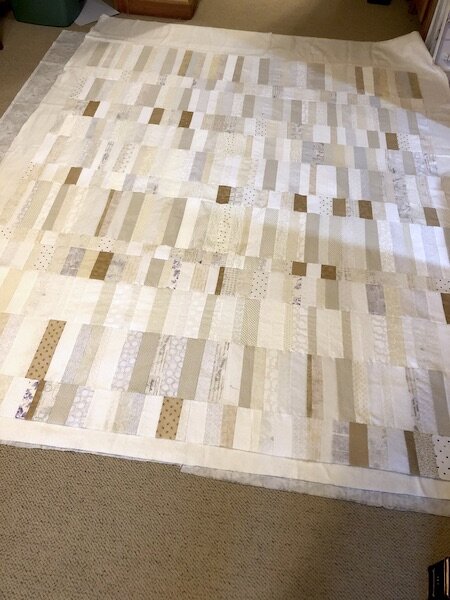Guerilla Sewing
I am chatty this week.
The Q20 is now safe from dust:
This is definitely not heirloom sewing. I was going for function, not aesthetics. The inside seams aren’t bound and probably never will be. The binding around the opening for the thread stand is kind of a hatchet job, but it sits underneath the stand and isn’t visible. I was exactly 1” short of binding on the bottom edge, but when I put the cover on the machine, I discovered that the 1” gap is right where the cord comes out of the back of the machine. I couldn’t have engineered that if I had tried. I am going to cut a notch out in that spot for the cord and go over the exposed edge of the foam and fabric with a zig-zag stitch.
Sometimes you just get lucky.
Done and done. I moved on to other projects. I basted the white/cream Candy Coated quilt in preparation for getting it on the machine.
If I scoot the Necchi cabinet out of the way, I have enough space on our bedroom floor to baste most quilts. When they get up to a queen or king size, though, I usually take them up to the church and do them in the fellowship hall (the floor there is carpeted). After I laid out all three layers, I went over the top and smoothed and pinned it. I also trimmed down the edges a bit. I need to leave a couple of inches of backing and batting extending past the top on all sides to account for shrinkage during quilting, but if I leave too much flapping at the edges, it can get caught underneath and sewn into the backing. Ask me how I know.
I haven’t decided how I will quilt this. I might try an allover paisley design. I could also quilt each row individually. I did that on another CC and liked the way it looked. The one issue I have with this pattern—and we’ll see how the Q20 handles it—is the number of seams. I’ve had a lot of problems quilting allover patterns on these quilts on the Janome because it tends to hiccup over the seams.
The backing on this one is a grey and cream toile pattern. I didn’t match the pattern when I pieced it; matching the pattern adds extra time to the process and I am in finishing mode right now. The print is busy enough that it’s hard to see the seam anyway.
I added the last bit of embellishment to the collage quilt and that one is ready for batting, backing, and quilting. Those collage quilts seem to benefit from plain grid quilting with 1” lines, so I’ll do that one on the Janome.
*****************************************************
I did a bit of quilt block detective work yesterday morning. Someone in the MeWe quilting group posted this picture and asked for help identifying this block:
I started with a Google image search, but Google assumed I was looking for American flags, not quilt patterns. I converted the image to grayscale and tried again, but that didn’t work, either. I did a Google search on “cog wheel quilt blocks,” which brought up a similar image on the Q is for Quilter blog. A bit further down the page of Google image results, I found this clipping, which matched the block on the Q is for Quilter blog post.
Aha. There was a note underneath this image that it came from the Ladies Art Quilt Company book, so I did a search on that title. That took me back to the Q is for Quilter blog, where I discovered thumbnail photos of each page of that book (it was published in 1922). I clicked on each thumbnail to enlarge the photos, and spotted what I was looking for on the eighth or ninth page:
Do you see it? This is block #212 from the Ladies Art Quilt Company book. The original poster of the question on MeWe was delighted that I was able to find this, but I am not sure it helps her much. These are just images, not patterns, and given the age of the publication, the block would have been done with templates, probably cut out of cardboard or heavy paper.
I was explaining this to the husband over dinner and showing him the photos. He commented that it was clear the maker of the original quilt block didn’t have the advantage of laser-cut—or even die-cut—quilt pieces. (Go back and look at that photo of the red, white, and blue quilt block, above; you can see that the quilter even pieced some of the individual units to use up tiny bits of fabric.) I am curious about all the quilt patterns than have fallen out of use over the past 100 years because they just didn’t lend themselves well to speedy rotary-cutting techniques. Noon and Night is a great example.
I think the potential is huge for resurrecting some of these patterns, especially if they can be die-cut with the Accuquilt dies. Accuquilt will make custom dies if you provide them the measurements (and are willing to pay extra). I need to finish Noon and Night (soon—it will be up right after the CC quilt) and get that pattern published, but my brain is awhirl with ideas.





